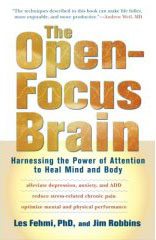The Origin of Pain
The scientific model of perception -- how we deploy our senses in order to experience life – has undergone an overhaul in the last couple of decades or so, but the revolutionary changes the overhaul has brought have gone largely unnoticed. The upshot is that the lion’s share of what we perceive, through sight, touch and other senses, is generated internally, in and by your central nervous system (CNS), your brain.
This finding has everything to do with our experience of pain, and is spelled out in our new book Dissolving Pain.
Dr. Richard Gregory, a professor of experimental psychology in the UK, wrote that the reason we experience pain when there is no physical cause, or itching when there is nothing apparently causing the itch, is because the role of our CNS is far more central to our experiences of pain than is the outer world. “Sensations of consciousness are created by the brain,” he wrote in the British Medical Journal. “Perceptions are predictive hypotheses, based on knowledge stored from the past.”
Ninety percent of perception, he believes, is based on memories.
Pain comes into the mix because emotionally charged memories lie at the root of physical pain, especially pain that seems to have no physical origin, such as chronic headaches and some kinds of back pain and phantom limb pain.
I know that it’s difficult for people who have an aching shoulder or back to accept the fact that the pain is not just located in the aching tissue but is largely in their mind and brain. Many of my patients say “it hurts so much it has to be in the muscle”, or “why would I create the pain?” Or they may feel they are somehow being blamed for the chronic pain, even though they have no idea what is going on. Or that it’s a way of saying that it’s all in their head. But it is real. The pain is very real and physical. The muscles are very tense and nerves are impacted. Muscles are just tensed for emotional reasons, not purely physical ones and often the shorted route to relieving the pain is through the CNS.
In an emotional situation, as far back as when we were small children, when we start to feel the discomfort of fear traveling throughout the body, we unconsciously and reflexively tense muscles control this fear. Muscles then stay tense to prevent the release of this emotional pain. Our minds and bodies are quite good at it. We labor to keep this pain distant from consciousness by narrowly focusing away from it. This tension related resistance eventually causes the pain to hurt more, and further activates the sympathetic autonomic nervous system, which produces increased arousal, which in turn causes more pain. Back pain or a chronic headache or stomach pain can activate the entire nervous system in this kind of loop and can go on for years.
Even pain that does have a physical cause often hurts more or longer than it might have because the brain is unstable from holding back these stressful memories. And if we narrow focus on this pain with a physical cause, the same thing happens as when there is no physical cause.
The key, as always, to dissolving physical or emotional pain, with an apparent cause or a cause that is not apparent, is to change our mode of attention from a narrow-objective one to a broad and immersed one with Open Focus training exercises.
In this expanded awareness we allow these feelings to be felt in a very mild way and are allowed to diffuse. When something is pleasant we feel it and allow it move on. Negative feelings can move on as well -- unless we pay attention to them inappropriately. If we broaden our attention, and expand our awareness, we break the loop that causes pain to linger and allow it to dissolve, and then we can go on our pain free way.
